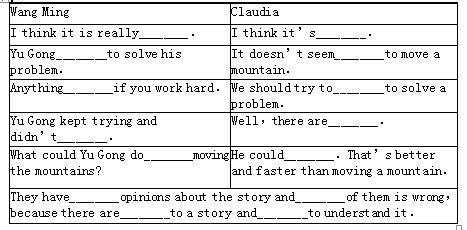根据下面的语言素材,用英语完成以下的设计任务(设计意图可以用中文表达)。
1.确定这节课的教学目标;
2.根据所确定的教学目标,设计教学过程并说明设计意图。
Teacher: So what do you think about thestory of Yu Gong?
Wang Ming: I think it′s really interesting.Yu Gong found a good way to solve his problem.
Claudia: Really? I think it′s a little bitsilly. It doesn′t seem very possible to move a mountain.
Wang Ming: But the story is trying to showus that anything is possible if you work hard!
Yu Gong kept trying and didn′t give up.
Claudia: Well, I still don′t agree withyou. I think we should try to find other ways to solve a problem.
Wang Ming: But what could Yu Gong do insteadof moving the mountains?
Claudia: Well, there are many other ways.For example, he could build a road. That′s better and faster than moving amountain.
Teacher: You have different opinions aboutthe story and neither of you are wrong. There are many sides to a story andmany ways to understand it.
1.Teaching Objectives
Knowledgeobjectives:
Students can mastersome words and phrases to express one's own opinion, such as "Really? I think .../But .../Well,I still don't agree with you."
Ability objectives:
(1) Students can usethe targeted words and phrases to doubt others' ideas and express their ownopinions.
(2) Students canimprove their listening and speaking abilities.
Emotional objective:
Students can developthe awareness that there are many sides of one thing and many ways tounderstand it.
2. TeachingProcedures
Step 1 Pre-listening
(1) Ask students toreview the story of "Yu Gong Moves a Mountain", giving clues likethis:
How did the storybegin?
What happened next?
Why was Yu Gongtrying to move the mountain?
(2) Askstudents, "What do you thinkof "Yu Gong? Is he wise or silly?" and lead students to give theanswer using "I think ..," Then the teacher says, "Well, but Idon't agree with you. I think ..."
设计意图:通过让学生根据提示回顾“愚公移山”的故事,为接下来的听力理解做铺垫;提问则加深学生对目标句型的印象,有利于后面的教学顺利开展。
Step 2While-listening
(1) Listening forthe gist
Listen to the tapeand find out what the conversation is mainly about:
A. Wang Ming is infavor of Yu Gong while Claudia is against him.
B. Claudia is infavor of Yu Gong while Wang Ming is against him.
(2) Listening forthe specific information
Listen to the tapeagain and fill in the following blanks.

(3) Listen to thetape for the third time. Pay attention to how Wang Ming and Claudia expresstheir opinions and fill in the following blanks:
Wang Ming:__________it' s really ...
Claudia: _____? __________it' s...
Wang Ming: _____ thestory is trying to ...
Claudia: _____,__________ _____ _____ _____ _____._____ _____we should try to ...
Wang Ming: _____what could ...
Claudia: _____,there are ...
设计意图:通过听材料大意、听细节信息的活动训练学生的听力能力,听并填写表达观点的词句则为后面角色扮演活动打好基础。
Step 3Post-listening
(1) Ask students torole-play the conversation in pairs and invite some pairs to perform to thefront.
(2) Set a situationand ask students to make a dialogue using the targeted words and phrases"I think .../But...". For example:
T: It' s said thatEnglish are more difficult to learn than Chinese. What do you think of theopinion?
设计意图:通过角色扮演和创设情境编对话的练习。锻炼学生的听说能力,并培养学生从不同角度看问题的思维能力。
我国保护少年儿童权益的专项法律是《中华人民共和国未成年人保护法》。( )
MP3( )。
计算机软件是指( )。
下面哪一项不属于维护交易安全原则的内容?( )
围绕《建国以来的重大科技成就》一课,做一个教案。
请围绕“城乡发展一体化”写一篇小论文,题目自拟,角度不限,要求:结构完善、条理清晰、有说服力。
在国际关系中,第三世界国家历来是中国团结合作的对象,因为 ①第三世界国家是国际社会一支重要的政治力量 ②团结第三世界国家符合中国的国家利益 ③合作是第三世界国家共同发展的必由之路 ④第三世界国家在南北关系中处于主导地位( )
微观经济学要解决的问题是( )
机关文书部门或业务部门在年终或第二年上半年对归卷的文件材料进行整理等工作,称为( )。
20世纪70年代中国外交有了重大突破和转机,转变的关键是( )